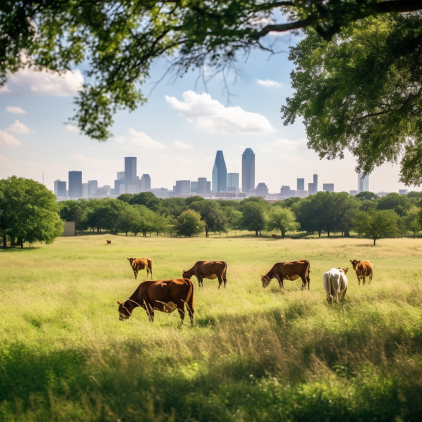Ranch investment has emerged as a popular investment realm in recent years. Especially for those seeking a steady income source, cherishing rural life, and willing to invest time and capital in long-term management, it can be an incredibly attractive option. Particularly in Houston, with its wealth of land resources and favorable climate for ranching, the potential for ranch investment is enormous.
The Allure of Ranch Investment
Firstly, we need to understand why ranch investment is so popular in the Houston area. Investing in ranches has many advantages: it provides not only a continuous income source (such as rent or sales of agricultural products) but also offers investors an escape from city bustle to enjoy rural life. Moreover, due to limited land supply, holding land for the long term can result in capital appreciation.
The Houston area, especially its surrounding counties, is seen by many investors as an ideal place for ranch investments. The relatively low land prices and the optimistic prospects for agriculture and ranching make investing in ranches an attractive choice.
Popular Ranch Investment Areas in Houston
In the Houston area, several regions are popular for ranch investments, each with its unique advantages and challenges. Here are five such regions:
- Walker County: Renowned for its rich wildlife and beautiful rural scenery, it’s an ideal place for ranching and hunting.
- Montgomery County: Located north of Houston, Montgomery County is teeming with ranches and farmlands, making it a hot spot for ranch investments.
- Grimes County: Favored by investors for its favorable ranching conditions and relatively low land prices.
- Madison County: With its wealth of land resources and temperate climate, it’s an ideal place for ranching.
- Washington County: One of the earliest counties in Texas, it has a rich history and cultural heritage and is an essential area for agriculture and tourism.
Land prices in these regions range from a few thousand to tens of thousands of dollars per acre, depending on the location, quality of the land, and available facilities.
Target Audience for Ranch Investment
So, who is interested in ranch investment? The target groups for ranch investments are diverse, including families seeking a rural lifestyle, investors looking for a stable income source, and companies and funds wishing to diversify their investments. Some people might be more focused on the recreational aspects of a ranch, such as hunting and fishing, while others might be more interested in the profit potential of agricultural production.
Finding Good Ranch Investment Opportunities
Finding good ranch investment opportunities requires patience and research. First, you need to clarify your investment goals and budget, which will determine what types of ranches you should focus on. Then, you can find potential investment opportunities through real estate brokers, real estate investment websites, local agricultural bulletins, and so on. When inspecting a ranch, consider the location, quality of the land, condition of existing facilities, and future improvements and maintenance work.
Return on Ranch Investment and the Resale Market
Returns on ranch investments come from two aspects: operational income from the ranch, including rent and sales of agricultural products, and land appreciation. However, ranch investments come with risks, such as weather factors affecting agricultural yield and fluctuations in the land market impacting land values. Therefore, investors need detailed financial planning and risk assessment.
In the resale market, the value of a ranch can be affected by several factors, such as changes in the agricultural market, regional economic development, and buyers’ demand for a rural lifestyle. If you plan to sell the ranch in the future, consider how to increase its value, such as improving facilities, increasing agricultural production capacity, or developing the land’s recreational use.
Overall, ranch investment is a challenging yet potential-filled investment field. Through wise decisions and careful management, investors can reap substantial returns from their ranch investments. The Houston area, with its unique geographic and climatic conditions, along with a stable economic environment, is an ideal place for ranch investment.
Top 10 Reasons for Investing in Houston Ranches: Here are the top 10 reasons to invest in Houston ranches:
- Limited land supply provides the potential for capital appreciation in the long term.
- Ranches can provide steady rental income and revenue from the sale of agricultural products.
- Experience country life, away from the hustle and bustle of the city.
- The mild climate and fertile land of the Houston area are suitable for various agriculture and animal husbandry.
- Ranch investment can be part of a diversified portfolio.
- Ranches can offer recreational and entertainment activities, such as hunting and fishing.
- Ranches can potentially be used for renewable energy projects, such as wind power and solar power generation.
- The cost of land in the Houston area is relatively low, lowering the investment threshold.
- Ranches can be used for ecological conservation and environmental education projects.
- Ranch investment may enjoy some tax advantages.
Top 5 Considerations for Investing in Houston Ranches: However, ranch investment isn’t for everyone. Here are five factors to consider:
- Ranch management requires time and effort. Are you willing and able to commit these resources?
- Ranch investment requires a long-term commitment. Are you willing to hold onto the land for the long term?
- Weather factors can affect agricultural yield and revenue from animal husbandry. Can you handle this risk?
- Market fluctuations can impact the value of the land. Can you deal with market uncertainty?
- If you plan to sell the ranch, do you have the ability and strategy to enhance the ranch’s value?
How to Address These Issues: Here are some possible solutions to the above issues:
- If you don’t have the time and energy to manage the ranch, consider hiring a manager or investing with a partner.
- If you’re worried about market uncertainty, consider diversifying your investments, or choose ranches that provide steady rental income.
- If you’re concerned about weather risks, you could buy insurance or choose to grow drought-resistant crops and hardy animals.
- If you plan to sell the ranch, consider enhancing the ranch’s value by improving facilities, increasing agricultural productivity, or developing the land’s recreational uses.
How to Invest in Houston Ranches: A Step-by-Step Guide: Here are some steps to invest in Houston ranches:
- Step one: Define your investment goals and budget. Are you looking to earn a steady income or hoping to gain through land appreciation? How much are you willing to invest?
- Step two: Look for investment opportunities. You can do this through real estate brokers, real estate investment websites, local agricultural bulletins, etc.
- Step three: Inspect the ranch. Consider the location of the plot, the quality of the land, the condition of existing facilities, and any potential improvement and maintenance work.
- Step four: Do financial planning and risk assessment. Consider the operational costs of the ranch, anticipated income, and potential risks.
- Step five: Make the transaction. You may need the help of lawyers and brokers to complete the deal.
- Step six: Manage the ranch. You can do it yourself or hire a manager or partner.
By following these steps, you can find suitable ranch investment projects in the Houston area and manage them effectively.
Regulations on ranching in Texas can vary by state or county. Generally, limitations on the number of horses, deer, or cows are usually calculated based on land area. For instance, some areas may stipulate that only one cow can be raised per acre. However, for specific regulations, you need to consult local animal husbandry regulations or inquire with the agricultural department of the county government.
Regarding beekeeping, Texas has a regulation allowing owners of agricultural land to apply for agricultural land tax relief through beekeeping. According to this regulation, owners need to carry out apiculture activities on a minimum of 5 acres (up to 20 acres) of land each year for five consecutive years. After meeting these conditions, the landowner can apply for agricultural land tax relief.
Please note, the information provided might not be entirely accurate as regulations can change based on the region and time. It’s best to consult with a lawyer or professional before making decisions to get the most accurate and up-to-date information.
In summary, ranch investment in Houston has tremendous potential and opportunity. As long as you have patience and determination, through wise decisions and effective management, you can reap substantial returns. That’s it for today. If you’re interested in ranch investment, stay tuned to our channel, as we’ll continue to provide more investment information and strategies. Also, if you found today’s content helpful, don’t forget to like, share, and feel free to discuss in the comments section.
Reference link: Houston Ranch Investment
RECOMCO can provide professional advice and strategies for ranch investment in the Houston area. We understand market dynamics and regional features and can provide a full range of investment services. Whether you’re just beginning to consider ranch investment or you’re an experienced investor, RECOMCO can provide customized solutions to help you successfully achieve your investment goals.
Thank you for watching, and we’ll see you next time!
Annie Luo is a multi-talented professional who has excelled in several fields throughout her career. With an early career as a pediatrician, Annie later transitioned to become a postdoc fellow and cancer researcher at MD Anderson Cancer Center. Driven by a passion for real estate, Annie made a career change into residential and commercial real estate and has practiced for the past 18+ years. Her entrepreneurial spirit led her to found her own brokerage practice, RECOMCO TX, where she continues helping her clients succeed today. Annie is not only a dedicated professional but also an active community member who supports charities through Alamo Fountain Center and the Global Federation of Chinese Business Women (GFCBW) – Southwest America chapter. She has served on the board for GFCBW for 6 years. She has been on the board for Alamo Fountain for the past 3 years. Her diverse experiences and achievements have shaped her into a well-rounded and accomplished individual.




